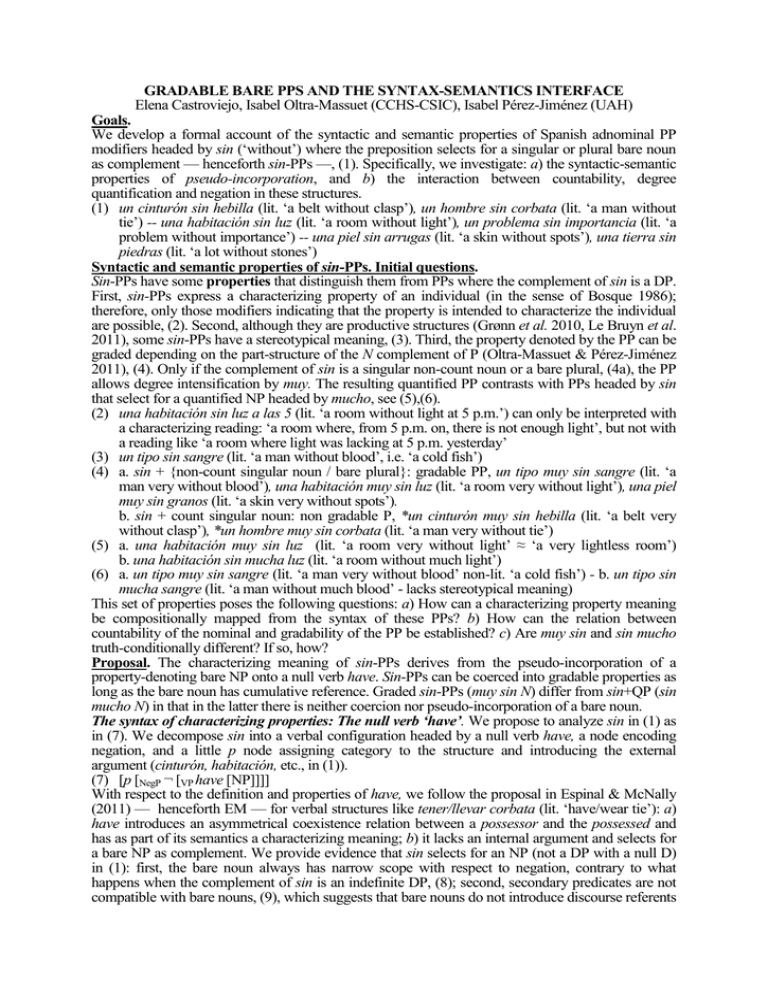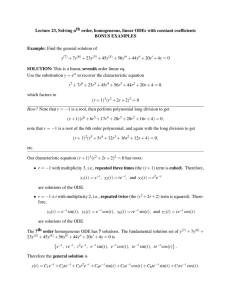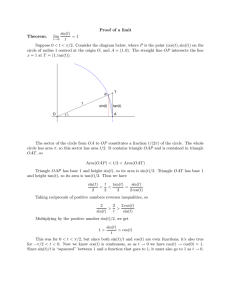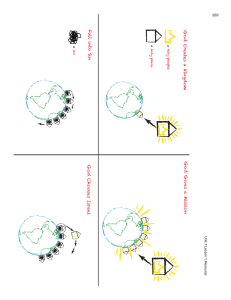Gradable bare PPs and the syntax
Anuncio

GRADABLE BARE PPS AND THE SYNTAX-SEMANTICS INTERFACE
Elena Castroviejo, Isabel Oltra-Massuet (CCHS-CSIC), Isabel Pérez-Jiménez (UAH)
Goals.
We develop a formal account of the syntactic and semantic properties of Spanish adnominal PP
modifiers headed by sin (‘without’) where the preposition selects for a singular or plural bare noun
as complement — henceforth sin-PPs —, (1). Specifically, we investigate: a) the syntactic-semantic
properties of pseudo-incorporation, and b) the interaction between countability, degree
quantification and negation in these structures.
(1) un cinturón sin hebilla (lit. ‘a belt without clasp’), un hombre sin corbata (lit. ‘a man without
tie’) -- una habitación sin luz (lit. ‘a room without light’), un problema sin importancia (lit. ‘a
problem without importance’) -- una piel sin arrugas (lit. ‘a skin without spots’), una tierra sin
piedras (lit. ‘a lot without stones’)
Syntactic and semantic properties of sin-PPs. Initial questions.
Sin-PPs have some properties that distinguish them from PPs where the complement of sin is a DP.
First, sin-PPs express a characterizing property of an individual (in the sense of Bosque 1986);
therefore, only those modifiers indicating that the property is intended to characterize the individual
are possible, (2). Second, although they are productive structures (Grønn et al. 2010, Le Bruyn et al.
2011), some sin-PPs have a stereotypical meaning, (3). Third, the property denoted by the PP can be
graded depending on the part-structure of the N complement of P (Oltra-Massuet & Pérez-Jiménez
2011), (4). Only if the complement of sin is a singular non-count noun or a bare plural, (4a), the PP
allows degree intensification by muy. The resulting quantified PP contrasts with PPs headed by sin
that select for a quantified NP headed by mucho, see (5),(6).
(2) una habitación sin luz a las 5 (lit. ‘a room without light at 5 p.m.’) can only be interpreted with
a characterizing reading: ‘a room where, from 5 p.m. on, there is not enough light’, but not with
a reading like ‘a room where light was lacking at 5 p.m. yesterday’
(3) un tipo sin sangre (lit. ‘a man without blood’, i.e. ‘a cold fish’)
(4) a. sin + {non-count singular noun / bare plural}: gradable PP, un tipo muy sin sangre (lit. ‘a
man very without blood’), una habitación muy sin luz (lit. ‘a room very without light’), una piel
muy sin granos (lit. ‘a skin very without spots’).
b. sin + count singular noun: non gradable P, *un cinturón muy sin hebilla (lit. ‘a belt very
without clasp’), *un hombre muy sin corbata (lit. ‘a man very without tie’)
(5) a. una habitación muy sin luz (lit. ‘a room very without light’ ≈ ‘a very lightless room’)
b. una habitación sin mucha luz (lit. ‘a room without much light’)
(6) a. un tipo muy sin sangre (lit. ‘a man very without blood’ non-lit. ‘a cold fish’) - b. un tipo sin
mucha sangre (lit. ‘a man without much blood’ - lacks stereotypical meaning)
This set of properties poses the following questions: a) How can a characterizing property meaning
be compositionally mapped from the syntax of these PPs? b) How can the relation between
countability of the nominal and gradability of the PP be established? c) Are muy sin and sin mucho
truth-conditionally different? If so, how?
Proposal. The characterizing meaning of sin-PPs derives from the pseudo-incorporation of a
property-denoting bare NP onto a null verb have. Sin-PPs can be coerced into gradable properties as
long as the bare noun has cumulative reference. Graded sin-PPs (muy sin N) differ from sin+QP (sin
mucho N) in that in the latter there is neither coercion nor pseudo-incorporation of a bare noun.
The syntax of characterizing properties: The null verb ‘have’. We propose to analyze sin in (1) as
in (7). We decompose sin into a verbal configuration headed by a null verb have, a node encoding
negation, and a little p node assigning category to the structure and introducing the external
argument (cinturón, habitación, etc., in (1)).
(7) [p [NegP ¬ [VP have [NP]]]]
With respect to the definition and properties of have, we follow the proposal in Espinal & McNally
(2011) — henceforth EM — for verbal structures like tener/llevar corbata (lit. ‘have/wear tie’): a)
have introduces an asymmetrical coexistence relation between a possessor and the possessed and
has as part of its semantics a characterizing meaning; b) it lacks an internal argument and selects for
a bare NP as complement. We provide evidence that sin selects for an NP (not a DP with a null D)
in (1): first, the bare noun always has narrow scope with respect to negation, contrary to what
happens when the complement of sin is an indefinite DP, (8); second, secondary predicates are not
compatible with bare nouns, (9), which suggests that bare nouns do not introduce discourse referents
to token individuals, but denote properties; third, nominal modifiers are only allowed if they specify
the kind of object the noun describes, but not if they are modifiers of individuals, (10).
(8) un hombre sin {amante/amantes} (‘a man without lover/lovers’) – unambiguous: ‘there are no
lovers at all’; un hombre sin una amante ‘a man without a lover’ – ambiguous: a) ‘there is no
lover’, b) ‘there is a specific lover that the man lacks’
(9) No puedo trabajar sin {*luz encendida/la luz encendida} (‘I cannot work without the light on’)
(10) No puedo trabajar sin {luz natural/*luz que entra por la ventana a las doce} (‘I cannot work
without natural light / light coming through the window at 12 o’clock’)
Pseudo-incorporation. We further assume, also following EM, that at the VP level in (7), a
compositional rule combines the nominal with the verb as a modifier. The combination have+bare
NP is interpreted as a complex predicate characterizing the external argument. That is, we argue for
a pseudo-incorporation process whereby the bare NP functions as a predicate modifier (Dayal 2011)
(contra Grønn’s et al. 2010 analysis of bare PPs headed by sin/without, where the bare noun selected
by the preposition is existentially bound). Since the complement of have is an NP, no syntactic
incorporation sensu strict takes place, so the NP stays in situ. This pseudo-incorporation process
explains cases like (3) because, as it is well known, the meaning of incorporated structures may be
non-compositional.
Gradability and negation in sin-PPs. As for the semantic mapping of (7), we simplify EM’s
proposal and apply it to the denotation of sin as sketched in (11).
(11) a. [[sin]] = N<et> x<e>. [HAVE-N](x)
b. [[sin luz]] = x<e>. [HAVE-light](x)
b. [[una habitación sin luz]] = Q<et> x.[room(x) [HAVE-light](x) Q(x)]
We take the property of lacking N to be coercible into a gradable predicate in Spanish, which is why
it allows intensification by muy, as shown in (12), where >>! should read “exceeds to a large extent”
and stnd is a function that takes a predicate and returns the standard of this predicate in a certain
context (Kennedy 2007).
(12) [[muy sin luz]] = x<e>.[ [HAVE-light](x)] >>! stnd( [HAVE-light])
To account for the paradigm in (4), we propose that sin-PPs can be graded as long as we can
imagine situations in which it might be significant to evoke a set of degrees of N-lacking. This
explains why the availability of such gradable PPs is highly context dependent; muy sin volumen
(lit. ‘very without volume’) is acceptable if it describes hair, but not if it describes a sphere, because
we can imagine degrees of volume-lacking when it comes to hair, but not to a sphere, which by
definition cannot lack volume. Count nouns such as corbata (‘tie’) can pseudo-incorporate into the
light verb, but they cannot participate in a graded PP because singular count nouns are quantized
expressions (Krifka 1986), so tie-lacking makes a property that can be either true or false, but
considering a set of degrees of this property is not possible (it would involve deconstructing the tie
into parts that are not ties themselves).
‘muy sin N’ vs. ‘sin mucho N’. Now we can account for the contrast in (5). In (5b) there is no
coercion of a PP denotation into a gradable predicate. Rather, intensification is applied to a mass
noun, (13a), which is gradable because it is a cumulative expression (Doetjes 2008). We assume that
mucha (‘a lot of’) introduces the function µ, which maps (dense) individuals to measures (Rett
2008), and that there is a >>! relation with a standard (as in muy ‘very’, (12)). Note that mucha luz is
not a bare noun, but a QP, of type <et,t>, which combines with sin, as shown in (13b).
(13) a. [[mucha luz]] = Q<et> X.[light(X) µ(X)>>! stnd(µ(light)) Q(x)]
b. [[sin mucha luz]] = y<e> X.[light(X) µ(X)>>! stnd(µ(light)) HAVE (X)(y)]
This proposal can also account for the contrast in (6). Whereas in (6a) pseudo-incorporation
results in a stereotypical meaning, the lack of pseudo-incorporation in (6b), where the
complement of sin is a QP, yields a compositional meaning, (13b).
References
· Bosque, I, 1986, El sustantivo sin determinación. Introducción, Madrid: Arco-Libros.
· Dayal, V. 2011. “Hindi pseudoincorporation”, NLLT, DOI 10.1007/s11049-011-9118-4
· Doetjes, J. 2008. “Counting and degree modification”, Recherches linguistiques de Vincennes 1:139-161.
· Espinal, M. T. & L. McNally.2011. “Bare nominals and incorporating verbs in Spanish and Catalan”, J. Linguistics, 47, 87-128.
· Grønn, A., Bert Le Bruyn, H. de Swart & J. Zwarts. 2010. Bare PPs across languages, Ms. Utrecht University.
· Kennedy, C. 2007. Modes of comparison. Elliott, M., J. Kirby, O. Sawada, E. Staraki and S. Yoon (eds.) Proceedings of CLS 43.
· Krifka, M. 1986. Nominalreferenz und Zeitkonstitution. Zur Semantik von Massentermen, Pluraltermen und Aspektk lassen. PhD thesis, U. München.
· Le Bruyn, B., H. de Swart, & J. Zwarts. 2011. Mass-count distinctions in bare PPs, Ms. Utrecht Institute of Linguistics OTS, Utrecht University.
· Oltra-Massuet, I. & I. Pérez-Jiménez. 2011. “La interacción contabilidad-gradabilidad en los SSPP escuetos”, Cuadernos de la ALFAL 3:138-158.
· Rett, J. 2008. Degree Modification in Natural Language, PhD thesis, Rutgers University.






